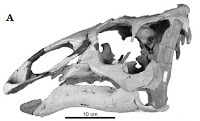In 2011 a group of palaeontologists led by Peter Makovicky of the Department of Geology at the Field Museum of Natural History in Chicago described a curious Ornithischian Dinosaur from the Late Cretaceous Javkhlant Formation of the eastern Gobi Desert in Mongolia, one of a series of fossils collected by a joint expedition of the American Museum of Natural History and the Mongolian Academy of Sciences. Named Haya griva, it appeared to be a member of the Ornithopoda, the group that includes the Iguanodontids and Hadrosaurs, but to be a member of a lineage that had separated from other members of the group before these major lineages diverged. This was unexpected in a Late Cretaceous Dinosaur, as no previous 'primitive' members of the Ornithopoda had been found later than the early Cretaceous.
In a paper published in the American Museum Novitates on 18 February 2016, Mark Norell of the Division of Paleontology at the American Museum of Natural History and Daniel Barta of the Richard Gilder Graduate School and Division of Paleontology at the American Museum of Natural History, describe a new specimen of Haya griva from the Zos Canyon beds in the Nemegt Basin of southern Mongolia.
The new specimen was collected before the formal description of Haya griva, and was at the time considered too poorly preserved to be assigned to a species. However re-examination of the material leads Norell and Barta to conclude that it shows enough features unique to Haya griva fot it to be assigned to that species. The specimen comprises a partial skull, some loose teeth, a radius and ulna, several carpals, phalanges, and unguals, and a partial dorsal vertebral series and associated ribs. It is articulated, but had apparently been largely eroded away prior to its discovery.
Partial skeleton of Haya griva. Norell & Barta (2016).
This specimen does not add greatly to our knowledge of Hoya griva, however it does shed some light on the age of the beds which produced it. The fossil-bearing beds of the Gobi desert in Mongolia are notoriously hard to date with any precision, lacking any volcanic layers which can be used in dating, magnetic rocks holding clues to the orientation of the Earth's magnetic field, or even much in the way of pollen. The Javkhlant beds at Shine Us Khudug, which produced the first specimen of Haya griva, have previously been identified as being Santonian-Campanian in age (between 86.3 and 21.2 million years old), and the presence of the species in the Zos Canyon beds of the Nemegt Basin suggests that these must be of a similar age.
See also...
 Morelladon beltrani: A Styracosternan Iguanodontid from the Early Cretaceous of Spain. Hadrosaurs, or Duck Billed Dinosaurs, were dominant herbivores in many
ecosystems across the Northern Hemisphere in the Late Cretaceous, but
the wider group of Iguandodontids from which they arose, the
Styracosternans, first appeared in the Late Jurassic...
Morelladon beltrani: A Styracosternan Iguanodontid from the Early Cretaceous of Spain. Hadrosaurs, or Duck Billed Dinosaurs, were dominant herbivores in many
ecosystems across the Northern Hemisphere in the Late Cretaceous, but
the wider group of Iguandodontids from which they arose, the
Styracosternans, first appeared in the Late Jurassic... Probrachylophosaurus bergei: A new species of Brachylophosaurin Hadrosaur from the Late Cretaceous of northern Montana. Hadrosaurs were large,
herbivorous Ornithischian Dinosaurs, commonly referred to as
'Duck-billed Dinosaurs', which...
Probrachylophosaurus bergei: A new species of Brachylophosaurin Hadrosaur from the Late Cretaceous of northern Montana. Hadrosaurs were large,
herbivorous Ornithischian Dinosaurs, commonly referred to as
'Duck-billed Dinosaurs', which... Ugrunaaluk kuukpikensis: A new species of Hadrosaurid Dinosaur from the End Cretaceous of Alaska. The
Prince Creek Formation of Northern Alaska is noted for the production
of numerous End...
Ugrunaaluk kuukpikensis: A new species of Hadrosaurid Dinosaur from the End Cretaceous of Alaska. The
Prince Creek Formation of Northern Alaska is noted for the production
of numerous End...
Follow
Sciency Thoughts on Facebook.

